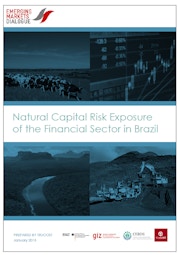
Brazil’s financial sector is dependent on natural capital to support economic growth and ensure future returns for investors. Nature’s assets are abundant in Brazil, from its farmland, forests and energy reserves to its ecosystem services such as the rainforest which helps regulate weather patterns.
However, there is mounting demand and supply side pressures on natural capital, including a rapidly growing population and deforestation. This renders natural capital increasingly scarce, leading to reduced crop yields, increasing input costs and disruption to supply chains. At the same time, there are financial and reputational risks for high-impact, high-dependence companies from the Brazilian government’s strengthening legislation to make companies pay for their environmental impacts and make banks more accountable for their financing decisions.
Financial institutions are exposed to natural capital risks through their investment and lending activities. For example, bank loan portfolios are likely to face higher credit risks if lending occurs predominantly to sectors and regions with high natural capital impacts and dependencies. For equity investors, shareholder value reduces as companies face higher operating costs, increasing costs of capital and asset degradation.
Investors and credit analysts are in need of better data and tools to integrate natural capital risks into investment and financing analysis in order to protect returns in the future. At the same time, there exists an opportunity for the financial sector to capitalise on the growing market for more sustainable and resource efficient business models. It can do this through investing in ‘best-inclass’ companies which better manage their environmental impacts, and by diversifying their portfolios to sectors that should benefit from changing consumer demand and environmental legislation.
Key findings from the report include:
- The Brazilian financial system is significantly exposed to natural capital risk because the sectors which banks and pension funds finance are heavily reliant on Brazil’s natural capital asset base.
- The study finds that the unpriced natural capital costs of companies which Brazilian financial institutions are financing amounts to R$1,646bn. Even if companies had to internalise only part of this cost, shareholder returns and loan repayments would be affected.
- Brazilian banks are more than twice as exposed to natural capital costs compared to pension funds. The study finds that banks, on average, had a natural capital exposure ratio (NCER) of 2.25 times. This ratio expresses the natural capital costs in relation to the financial value of the investment. For pension funds the NCER was 0.8. This indicates that the banks invest more in sectors with higher levels of unpriced natural capital cost which could translate into higher risk exposure.
- Banks are most exposed through their financing of cattle ranching, agriculture, fishing, and food and beverage, while pension funds are most exposed through their investments in food and beverage companies.
- Depending on the proportion of lending to different sectors and regions, the natural capital risk exposure of a financial institution can differ significantly. The study’s comparison of the natural capital risks of two banks demonstrated that one has significantly greater exposure to sectors and regions with high natural capital costs (NCER: 5.5) than the other (NCER: 2.25). The first bank is twice as exposed as the banking sector average (NCER: 2.2).
- Sectors with the highest natural capital costs in Brazil are cattle ranching (R$2,629,205m), soybean farming (R$232,486m) and crude petroleum and natural gas extraction (R$147,303m). This is due to the high production levels and natural capital intensities of these sectors.
- The sectors with the highest natural capital intensities (R$m unpriced natural capital costs per R$m of revenue) are: cattle ranching (R$22.123m), fats and oil refining (R$4.275m), aquaculture (R$3.875m), animal slaughtering (R$3.709m), cotton farming (R$3.252m), soybean farming (R$2.937m), sugarcane farming (R$2.040m) and cement manufacturing (R$1.347m). These sectors should be priority areas for further research and engagement activities by financial institutions.
- Revenue at risk, which compares a sector’s natural capital costs to its total revenue, is a useful indicator for investors to show the potential exposure of a sector. For instance, the animal slaughtering, rendering and processing sector in Brazil is exposed to natural capital costs that are 371% greater than the total revenue of the sector. The natural capital costs of the petroleum manufacturing sector account for 94% of its total revenue.
- Cattle ranching is the sector which has by far the highest level of unpriced natural capital costs and the highest natural capital intensity. Some 90% of the impact comes from the farming stage due to land-use conversion and methane emissions from livestock. Cattle ranching occurs in all regions of the countryand therefore has different levels of natural capital intensity. Around 19% of production is in the highly valuable Amazon region in the North of Brazil, whereas 11% of production occurs in the South, which has the lowest natural capital intensity.
- The North of the country has the highest land-use conversion cost because it is principally made up of Amazon rainforest which has a high natural capital value.
- There is a marked difference in the natural capital impacts of soy production in the two principal production zones. As much as 47% of soybean production is in the Central West region which has twice the land-use conversion cost as soybean production in the South where 37% of the crop is produced. This is driven by the high natural capital value placed on Brazilian Cerrado – the savannah which dominates the Central West.
Publish your content with EB Premium
It's not about how many you reach. It's about who. Get your news, events, jobs and thought leadership seen by those who matter to you.
















